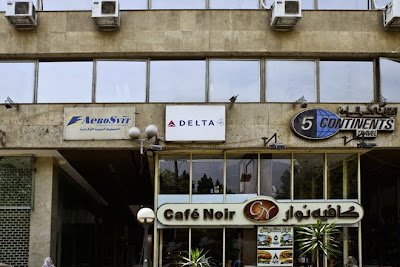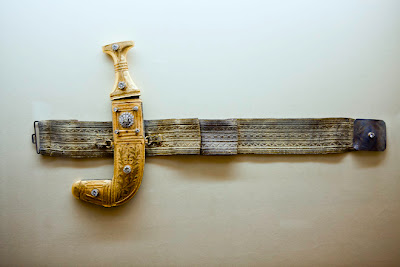Woke this morning to CNN blaring the news that there was a major air-traffic snarl in Europe. An Icelandic volcano was spewing ash into the air space of most Northern European cities, causing flights to be canceled and tons of passengers to be stranded.
I had an appointment at the Antiquities Office this morning to finalize my plans for the next couple of days, but news of the volcano made a stop at Delta Airlines essential.
Their office is on the second floor of a shabby office high-rise located at 21 Ismail Mohamed Street, in Zamalek. I got there just after 9 a.m. and took the stairs up. I've been visiting this office for the past few years, and every time I come in, the girls behind the counter start giggling at my appearance. They finally stopped long enough to reconfirm my reservation and nonchalantly tell me not to worry, that everything at Delta was under control and there would be no problems.
After that good news, I made my way over to the Antiquities building and to the inspectors' section of offices. I found Mr. Ismail, who was expediting my itinerary. I inquired if everything was set for my visit to Tuna Gebel the next day and the Egyptian Museum the day after. He smiled and assured me that everything was hunky-dory. He gave me the name and cell phone number of the local inspector who would show me around Tuna Gebel once we got there.
My first stop of the day was Abdeen Palace. The 550-room former royal palace is now mostly reserved for housing visiting foreign dignitaries, but the public is allowed to visit a small portion converted into a museum to house weapons presented to Egypt's heads of state, whether kings or presidents.
After parking in the lot next to the ticket booth, I went over to purchase my ticket while Magdy got hassled by the tourist police, who were making sure he had the proper papers to be chauffeuring a tourist around. I paid my 15 pounds and crossed the street to the entrance, about a half-block away. The museum is always crowded with groups of school kids on field trips, and today was no exception. I stood in line, then made it through security and came out into the courtyard that King Farouk once called his own.
I have felt a kinship with Malek ever since my first visit to Egypt in the 1980s. I'm told I resemble him, and people in the streets ask if I am related. In those days, people were still full of General Nasser's propaganda, so their comments were a little on the harsh side, but with time, Egyptians opinions have mellowed about their late king. He wasn't an intellectual, but he was cunning. They've come to realize he was not the drunken fool he was portrayed as. As a point of fact: Farouk never had a drink of alcohol in his entire life. He preferred "fizzy drinks" (soda pop), another thing we have in common.
Although in Egypt Farouk's name has mostly been erased or obscured, in the Abdeen Palace museum you can still see a few things that belonged to him personally. Farouk was a world-class marksman, and many of the weapons here had been used by the avid shooter. One of the stories that best illustrates his prowess is that when he was deposed, he fled in his red convertible sports car (in Egypt, only the king was allowed to drive a red car) to xxxx palace in Alexandria, where his household and 500-person Sudanese body guard were. You would think he would have taken cover inside, but instead, he was up on the roof, firing at the "Free Officers" intent on ending his life and reign. In the end, a combination of his marksmanship, his dispatching of at least four of the opposing force, and the loyalty of his Sudanese defenders enabled a negotiation that allowed Farouk to abdicate and sail away into a life of luxurious tedium.
I visited the museum a couple of years ago, but all my pictures had turned out blurry. You can't bring in a tripod or use a flash, so I'd brought my 5D this time and set the ISO to 6400. I took a lot of photos, but the light is so low in spots that I didn't expect to have more than a few sharp, in-focus shots.
My next stop was the Windsor Hotel. Built in the 1950s, it was at one time held in high regard by Americans and Europeans making the grand tour. Today, it is at best a budget hotel with just small glimmers of its former glory. The place reminds me of locations from the movie "The English Patient." The staff was very cordial and allowed me to shoot in the bar and their famous elevator.
From downtown Cairo we then headed east to the City of the Dead. Our destination was the Tomb of Mohamed Ali, the founder of the modern state of Egypt and the great-great-grandfather of Farouk. He was the Armenian commander of the Ottoman forces who had overcome the Mamluks and united Egypt. His tomb is done in the extravagant Turkish style. The Mamluk leaders whom Ali had strangled at his famous party are also buried here, as proof of his accomplishment. You will find the interior of the tomb pretty dark, and unless you're the only visitor there, you won't be allowed to use a flash. The tomb has seen better days, and the caretakers, who knew that Dr. Hawass was a friend of mine, asked that I bring the situation to his attention, and I agreed.
Magdy dropped me off at the hotel at 4:30 and said he'd be back to take me to the awards dinner at the Sphinx at 7:30.
I went up to the fifth floor and out onto the patio restaurant to order a lemon juice. I watched the Nile go by for an hour, then returned to my room to lie down for a while so I'd be rested for that evening.
At 6:45, dressed in my party best, I walked down the street to the back of the Television Broadcast building and found a guy shining shoes. I put my black Timberland six-inch boot up on the shine box and agreed upon a price. The young man began his ritualistic movements, humming a little sing-song as he worked away. By the time he had finished and I'd paid, there was a queue of four other gentlemen waiting to have their shoes blacked.
I was waiting on a bench outside the hotel when Magdy pulled up. I double-checked that I had the invitation and then got into the Toyota. It took about 30 minutes to get to the Giza Plateau. The invitation was for 8 p.m., but when we got there at 8:10, the Sound and Light show was still going on. The police said we'd have to wait. Magdy suggested we wait at the tea shop down the block.
The shop's interior was decorated like a Bedouin tent, with billowing canvas panels hanging from the ceiling. I ordered tea, and Magdy wanted Turkish coffee. We had only been there a little while when the place got totally reconfigured to accommodate the arrival of a group of Indian tourists. All twenty were seated at one large, makeshift table, across which they had to yell to hear each other from one end to the other. Magdy and I were moved closer to the door, allowing me to kept a lookout for the end of the light show.
Around 8:50 we paid the check and wandered back up to the entry gate. Just before 9 p.m. the police got the OK to begin letting in guests. They checked invitations, then let us walk the couple of hundred yards up to the screening area. That took a while, but finally we were in the designated dining area.
It took a while to get everyone in and seated, but finally, just before 9:20 p.m., the program began, with 10-minute film on the relocation of the two temples of Abu Simbel in Nubia. Following that, an MC came out and explained the significance of the awards being handed out, then Dr. Hawass came up and called out each award winner, one at a time, and explained their contribution to Egyptology and to Egypt. Each winner gave a very short acceptance speech. This all ended just before 10 p.m., right as Magdy called me to say it was getting late and that if we were going to Tuna Gebel the next day, we should head out. As fashion-show dancers in Egyptian costumes were beginning to gyrate, I made my exit and found Magdy waiting.
The traffic was very heavy on Pyramid Road on the way back. It took more than an hour to get back to the Hilton. I had to spend another 40 minutes getting ready for the next day, then I set the alarm and hit the rack.








































No comments:
Post a Comment